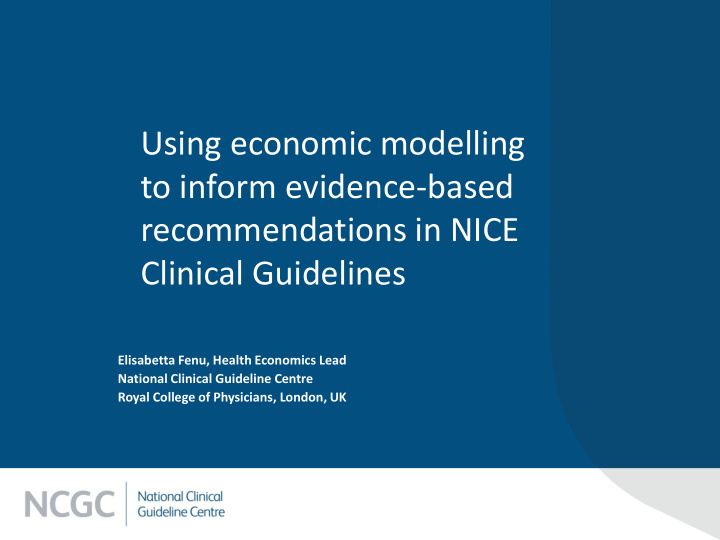



Using economic modelling to inform evidence-based recommendations in NICE Clinical Guidelines Elisabetta Fenu, Health Economics Lead National Clinical Guideline Centre Royal College of Physicians, London, UK
Background • The National Clinical Guideline Centre (NCGC) is commissioned by the National Institute for Health and Care Excellence (NICE) to develop evidence- based clinical practice guidelines. • Health economic analyses, including economic models, are developed to inform recommendations.
Aims To describe usefulness of economic models: • To ensure that good value-for-money interventions are implemented (trade-off between clinical benefit and costs) • To link intermediate endpoints to final outcomes (extrapolation) • Decision models can provide a single outcome measure that incorporates multiple benefits and harms of interventions. The Quality-Adjusted Life Year (QALY) is the preferred measure of health outcome and incorporates both quality of life (QoL) and life expectancy/mortality.
An example from NCGC Guidelines Venous thromboembolism (VTE) guideline Question: cost-effectiveness of long-term treatment with vitamin K antagonist (VKA) in patients after an unprovoked VTE. • Trade-off between risk of VTE recurrence and risk of major bleeding. • Recommendations could not be made only on the basis of the clinical review.
Methods – model structure TOTAL COSTS Cost of VKA Major bleeding Continue VKA treatment treatment (lifetime) Cost of treating 3 months major bleeding after VTE Recurrence unprovoked VTE Cost of Baseline risk (pulmonary treating VTE x Risk embolism Ratio(treated) [PE] or deep vein TOTAL QALYs Major bleeding thrombosis Stop VKA [DVT]) QoL and treatment mortality – major bleeding VTE Recurrence QoL and Baseline risk mortality – VTE recurrence
Methods – assessing cost-effectiveness 1. Mean costs and QALYs for the average patient with an initial unprovoked PE and DVT were estimated from the model. 2. We calculated the incremental cost-effectiveness ratio (ICER) of indefinite treatment: 𝑑𝑝𝑡𝑢 𝑗𝑜𝑒𝑓𝑔𝑗𝑜𝑗𝑢𝑓 𝑢𝑠𝑓𝑏𝑢𝑛𝑓𝑜𝑢 −𝑑𝑝𝑡𝑢 𝑜𝑝 𝑢𝑠𝑓𝑏𝑢𝑛𝑓𝑜𝑢 𝑅𝐵𝑀𝑍𝑡 𝑗𝑜𝑒𝑓𝑔𝑗𝑜𝑗𝑢𝑓 𝑢𝑠𝑓𝑏𝑢𝑛𝑓𝑜𝑢 −𝑅𝐵𝑀𝑍𝑡 𝑜𝑝 𝑢𝑠𝑓𝑏𝑢𝑛𝑓𝑜𝑢 ICER = 3. We compared it with NICE threshold of £20,000 per QALY gained. • After a PE, indefinite VKA treatment was cost-effective (ICER = £10,000/QALY) • After a DVT, it was not cost-effective (ICER=£83,000/QALY) because fewer PE recurrences in this group.
Sensitivity analysis – initial DVT Cost-effectiveness of indefinite treatment with VKA RISK OF MAJOR BLEEDING RISK OF VTE RECURRENCES baseline 2 x baseline 3 x baseline 3 x baseline 2 x baseline baseline 7
Sensitivity analysis – initial PE Cost-effectiveness of indefinite treatment with VKA RISK OF MAJOR BLEEDING RISK OF VTE RECURRENCES baseline 2 x baseline 3 x baseline 3 x baseline 2 x baseline baseline 8
Results - VTE example We incorporated the difference in cost-effectiveness for patients with an initial DVT compared to patients with an initial PE. A. Offer a VKA beyond 3 months to patients with an unprovoked PE , taking into account the patient’s risk of VTE recurrence and whether they are at increased risk of bleeding. B. Consider extending the VKA beyond 3 months for patients with unprovoked proximal DVT if their risk of VTE recurrence is high and there is no additional risk of major bleeding. 9
Limits • Sometimes models are based on limited clinical evidence (e.g. parameters obtained from a meta- analysis of only a few trials, or from a slightly different population). • Often they rely on assumptions (e.g. risk ratio for subgroups outside the evidence base). • Transferability could be an issue: costs and threshold vary according to budget and health care setting.
Bottom line • Economic models are useful tools for identifying the most appropriate intervention for subgroups of patients. • In the example, the clinical reviews alone would have never been able to inform detailed recommendations. • If there are tools to quantify the risk or to assess the risk factors, decision models are the best way to combine them with clinical evidence and make them more useful.
Thank you! Any questions?
Recommend
More recommend